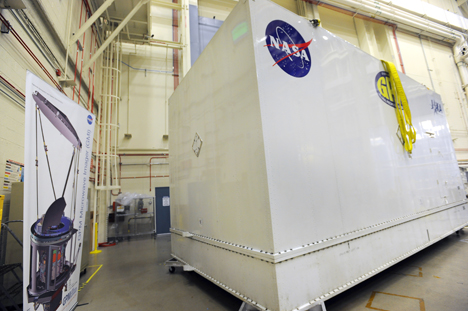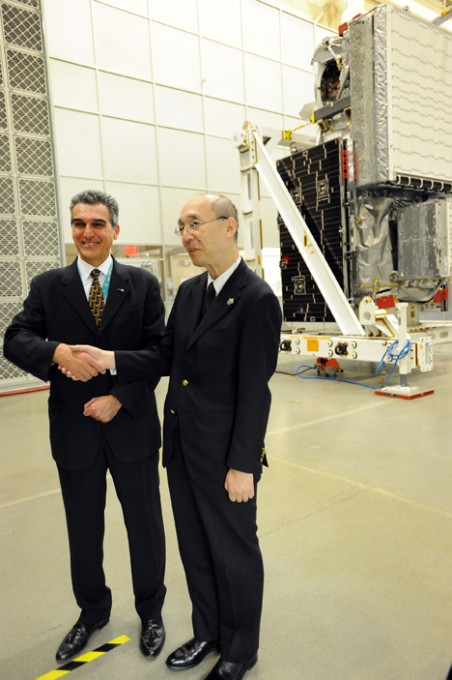

At 4:30 a.m., Nov. 21, a knock came at the door of the Goddard bus from one of our Air Force escorts at Andrews Air Force Base, outside of Washington, D.C. It was time to board the Super Galaxy C5 cargo plane. The NASA team of 24 slowly woke up from the naps most of us were taking while we waited in the warmth of the bus. We arrived at Andrews at midnight for a 2:00 a.m departure that was pushed to 3:30 a.m. then 4:30 a.m. while the C5 crew finished loading and securing the cargo.
A few people grabbed bags that they hadn’t taken up to the passenger section when we first arrived, and we file up the ramp into the belly of the massive C5. It’s a little bit like I imagine being swallowed by a whale might feel.
When the Global Precipitation Measurement mission’s project manager Art Azarbarzin first told me that in addition to the GPM satellite’s shipping container, we were taking along the roller bed truck, minus the engine, I didn’t know how to picture it in my head. I’d seen the shipping container. I knew it was big, and I couldn’t conceptualize how it and a truck would all fit onto a single aircraft. But the C5 is truly huge, and there the truck was, chained to the deck.

The roller bed truck loaded on the plane. Secured on top are the FlipRight (yellow) for manipulating the spacecraft once it’s in the cleanroom in Japan and the I-beam sling (white) that facilitates the heavy lifting of the container. Credit: NASA / Michael Starobin
Immediately behind the truck at the center of the plane is the GPM shipping container, its top clearing the ceiling by an inch and its width taking up all but two narrow aisles to either side. On each side, sixteen thick chains strapped the shipping container to the deck. They angled up in the walkway, making for a nice tripping hazard to pick our way through.
Behind the shipping container is more cargo space where six loaded pallets were strapped down: our vacuum-wrapped luggage, the secondary environmental control unit and generator for the shipping container, the flight and spare batteries for the spacecraft, and boxes of tools and equipment for moving and handling the shipping container. From the ceiling, attic stairs descend, narrow and steep, up to the passenger section of the plane above.
Gripping the railing with two hands, we file up. My first impression was that it is very blue — blue seats, blue floor, blue ceiling and walls. The rows only stretch back about half the length of the plane, three seats to a side. With only 24 of us, those who are working the unloading get first pick of a full row to themselves.
Once everyone gets situated, we get the same FAA safety briefing, you’d get on a commercial flight: Put you seat backs and tray tables in their upright and locked positions. Ours however was read from a manual by a young airman, getting through the words as quickly as possible. When it was time for the demonstrations, we skipped the seatbelt buckle and got a lesson on how to put on what is essentially a bubble over your head that will keep out smoke and provide oxygen in case of a fire.
As the rest of us shut off our electronics, Mike Miller and Neil Patel in the seats across the aisle fired up their laptops. They’re two of the team that monitors the spacecraft inside the shipping container 24/7. An ethernet cable from the sensors in the container stream a constant feed of what’s happening in there — temperature, humidity and vibration — so they can make sure everything is where it should be. They’ll be on for the whole flight.
While we waited for take-off, most of the team sacked out under the blue wool blankets distributed with the noise of the engine muffled by ear plugs. It was cold up there. The only windows are over the four emergency exits so the only way to tell we were moving was the vibrations through the floor and change in pitch from the engines. But it wasn’t long before they roared to life and we were in the air and on our way.
“To: Japan, Love: GSFC.” So says a note, written in black marker on the outside of the Global Precipitation Measurement (GPM) shipping container. This is at least the fourth satellite that has been transported in this particular container. Stenciled officially on another corner are XTE, TRMM, and Landsat-7. Someone on a previous transport team left a note on an external box used to secure the container to the C5 that reads: “To The Poor Crew of GPM. Miss, and Love you All, ‘B’.” On the fourth corner is a small heart.
The day the GPM team loaded this well-loved container and its cargo onto the C5 cargo plane was a long day. It began at Goddard Space Flight Center in Greenbelt, Md. at noon on Nov. 19, beautiful and blustery, and ended at around 2:25 in the morning, dark and bone-chillingly cold at Andrews Air Force Base. Everything moved slowly: the drive from Goddard, the transfer of the shipping container from one truck to another, the loading of the plane.
“Be extremely cautious, take your time,” said mechanical team member Dani Alvarado as he briefed everyone before they got started. “This is the real deal.”
Here are the highlights.
12:00 p.m.
The first leg of GPM’s journey was by truck to Andrews Air Force Base, escorted by a van and a pickup advertising the oversize load. Behind, followed a caravan that included those of us accompanying the satellite. The center section of the truck-trailer carrying the container is only about a foot or so off the ground, so the top of the container was low enough to clear the two underpasses on its route. At first, everyone in the bus trailing behind ducked their head into the aisle to make sure it made it under. It did, just barely.
~4:00 p.m.
Once we arrived at Andrews Air Force Base the first task was to transfer the shipping container from the truck it rode in on to a truck bed covered in rollers. The roller bed, specially designed for NASA satellite transportation, allows the container to move smoothly from the truck to the plane. The roller bed truck followed in the caravan from Goddard, bringing with it two pieces of equipment: a FlipRight machine for moving the satellite around once it arrives in the clean room in Japan and the I-beam sling shown above that attaches to the crane to lift the container. Altogether, the satellite, container, and sling weigh about 62,000 pounds. Up the container went, the first truck drove out from under it, and the roller bed truck backed up under the container in its place.
8:00 p.m.
Originally the C5 was supposed to arrive at 4:30 p.m., but birds on the runway in Dover where it was coming from caused a delay. Since they’re close to a refuge, the Dover base keeps “bird hours,” and can’t take off until they fly away to roost. So the GPM team took a dinner break. The C5 arrived after dark at 6:45 p.m. as three lights on the horizon. It took another hour for the crew to taxi and get the plane ready with its nose in the air, looking like a shark with its jaws open.
~8:30 p.m.
As soon as they could, the GPM team got started prepping the plane for the container. The floor of the C5 has rows upon rows of small rollers down the center, but since the container is wide, the GPM team laid down metal covered wood tracks. Next they attached mounts to the outside of the shipping container that would hold roller skates that they put into place as the Air Force crew pulled the container onto the plane with a chain in short bursts.
~10:30
The shipping container is about an inch shorter than the distance from floor to ceiling of the cargo area on the C5. Wiggle room was practically non-existent. The roller truck had to back up, pull out, and back up again to get the container perfectly aligned. The Air Force crew had to adjust the height of the docking platform so the weight of the container shifted directly onto the plane and the container remained level. There were a few false starts, but the container made it on board in the end, looking like it was being swallowed whole.
1:10 a.m
Darkness made it hard to fully appreciate the size of the C5, but taking a look inside and seeing the shipping container look small really brought it into perspective.

The shipping container that will carry GPM to Japan. Comes complete with environmental regulation to keep the humidity and temperature just right for the spacecraft. Credit: NASA
Right now if you want to take a look at the Global Precipitation Measurement mission’s Core Observatory, you can’t. As of last weekend, it’s sealed up inside a giant white shipping container, all prepped for its long journey to Japan where it will launch in early 2014.
This isn’t your typical satellite delivery. As Project Manager Art Azarbarzin says, we’re not just driving by truck across a couple states to a U.S. launch site. GPM will be traveling by truck to an Air Force C5 cargo plane which will fly it over the United States and the Pacific Ocean to Japan. Once at the airport on Kyushu, it will be transferred to a barge that will take it to Tanegashima Island, where NASA’s mission partners, the Japan Aerospace Exploration Agency, or JAXA, have their spaceport.
My bags are packed too. As the science writer for the GPM mission, I’ll be traveling with the satellite and the engineering team that’s accompanying the spacecraft. getting the behind the scenes story of GPM’s road trip. I’ll be sending back photos and stories of each leg of the journey, and once we arrive, introduce you to living and working Tanegashima, Japan.

NASA’s GPM Project Manager Art Azarbarzin (left) and JAXA’s GPM Project Manager Masahiro Kojima in front of the GPM satellite at its last public appearance on Nov 15, 2013. Credit: NASA
Every satellite’s shipment to the launch site is a big moment, but for GPM it feels especially poignant because the spacecraft was built and tested in-house at Goddard Space Flight Center. Over 300 people worked on it here, and have seen it come together day by day. At our recent Friends and Family Day, the energy of the team was palpable as they shared their excitement for the mission and the satellite they had built together with their loved ones.
For me, the second story I wrote when I began working at Goddard was about testing part of the frame for the body of the GPM spacecraft on Goddard’s high capacity centrifuge. Since then I’ve covered both the engineering milestones and stories about the science GPM will do to improve rain and snowfall measurements from space, as well helped the science team share their work on field campaigns like the Iowa Flood Studies in preparation for GPM’s launch.
That launch is almost here is a little surreal but I’m very excited as we begin this final phase before liftoff. Stay tuned.